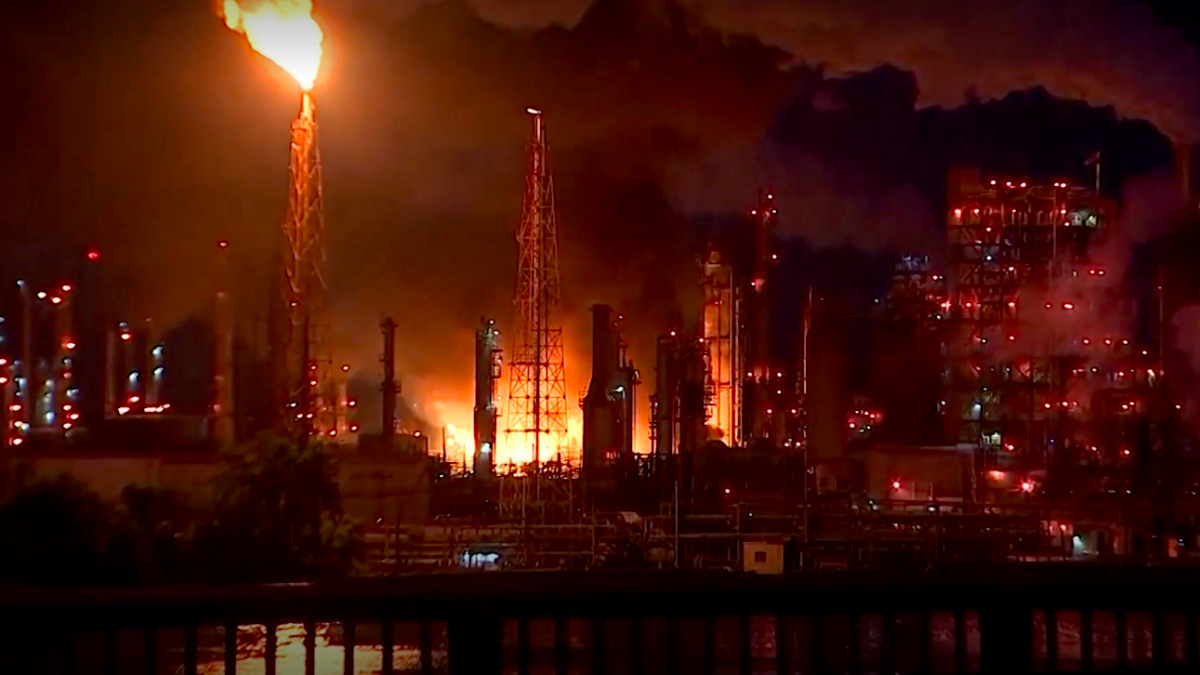Jeanette Miller was overjoyed when she heard the news that Philadelphia Energy Solutions was closing its sprawling South Philadelphia refinery, which had the unenviable reputation of being the city’s biggest single source of air pollution.
“Oh my God, it was a miracle,” said Miller, sitting on the front porch of her row home barely a mile downwind from the refinery whose emissions she blames for her asthma and other illnesses suffered by her family and neighbors. “They ignored us for so long.”
Miller, 62, who has lived in the Grays Ferry neighborhood all her life and in her current home since 1990, said she’s going to fight against any plans to restart the refinery or remake it as any kind of fossil fuel facility. Instead, she wants the site cleansed of more than a century’s worth of industrial contamination at the expense of the owners. She also wants the 1,300-acre site to be reused for clean-energy generation or for new affordable housing.
She’s fighting as part of Philly Thrive, a community group that campaigns for clean air and renewable energy.
“We’re going to do everything in our power not to let that happen,” said Miller, referring to a possible restart of the refinery. “I would like the land to be brought back to its natural state, and rid of any contaminants so you can build on there without being worried that one day you will have an illness.
“Solar panels would be nice, something positive that we can benefit from,” said Miller, wearing a handwritten note across her chest that read Breathe. “We don’t want any more fossil fuel projects to be built across the street.”
The June 26 announcement of the refinery closure following a disastrous fire and explosion just five days earlier unleashed a flood of speculation about what will happen to the massive site, which occupies a huge chunk of South Philly bordered by 26th Street to the east and the Schuylkill River to the west.
The refinery’s owner, Philadelphia Energy Solutions, said it would “position the refinery complex for a sale and restart,” but a week later, it was unclear whether any potential buyer would take on a facility that is heavily contaminated, financially fragile and holds an ugly reputation as the city’s biggest single emitter of air pollution and greenhouse gases. The company filed for bankruptcy in January 2018 and emerged from it in August of the same year.
Environmental advocates called the shutdown a unique opportunity for Philadelphia to use the site for advancing its clean-energy agenda, which aims to cut carbon emissions by 80 percent from recorded 2006 levels by 2050. Whether some or all of the site could be reused to create a massive solar farm, or perhaps just open space, was among the possibilities raised not only by green campaigners but also by an energy infrastructure investor whose company is backing a new liquefied natural gas terminal next to the PES site.
“It truly is a generational opportunity for the city and the Commonwealth to find [out] what we’re going to do with that space,” said Matthew Taylor, a partner with Liberty Energy Trust, which has invested $60 million in the Passyunk Energy Center. It also includes plans to build five megawatts of solar power and other clean energy installations. “You can’t find another major city in North America that has that much land being used for a single purpose that may be changing.”
Taylor urged the City of Philadelphia to set up a “blue ribbon” panel to decide on the future of the site, representing the interests of all stakeholders.
He said there is definite interest in at least some of the site from energy investors, but it’s not clear how much of the site could be revived as a fossil fuel facility and how much might be repurposed.
The site may still have a future as a petrochemical hub, given its extensive infrastructure, rail lines, industrial electric supply and an expert (though soon to be laid-off) workforce, Taylor said. But he speculated that might mean one of the two refining units will be shut down with its land reused for some other purpose.
He downplayed concerns that the site is so polluted that its future uses are very limited. While it’s not realistic to expect the land can be reused to “grow tomatoes,” it could be reused for other purposes if contaminated soil was encased, he said.
“It may just mean encapsulating the pollution and making it so that you can do commercial and industrial operations there,” Taylor said. “I’d be surprised if it ever got to the point where you had residential apartments.”
The Pennsylvania Department of Environmental Protection, which has been working with the U.S. Environmental Protection Agency to clean up the site since the early 2000s, said the size of the site and the fact that it has been refining oil since 1866 means it’s hard to be specific about the nature and scale of the contamination.
But DEP spokeswoman Elizabeth Rementer said soil and groundwater there have been contaminated with hydrocarbons, and there are “numerous” places where toxic chemicals including lead, toluene, benzene and MTBE have been detected.
The two agencies have been undertaking “extensive remediation,” and the DEP is now reviewing all its permits there in light of the closure announcement, she said.
Whatever the extent of the cleanup, contamination is likely to constrain future uses of the site, said Mark Alan Hughes, faculty director of the University of Pennsylvania’s Kleinman Center for Energy Policy, which advocates for policies that promote a transition to sustainable energy.
Given that the site also has outdated infrastructure, it’s likely to face some other future use, such as a solar farm, Hughes said. He argued that a large-scale solar installation could be achieved without a comprehensive cleanup, which he said would be prohibitively expensive.
Hughes, who was the City of Philadelphia’s first director of sustainability under former Mayor Michael Nutter, compared the PES site to Penn Park, a 24-acre university sports ground on the west side of the Schuylkill River, where industrial contamination meant the space could not be used for student housing or classrooms.
“That’s going to be an instructive example,” he said. “There were a couple of centuries of increasing intense industrial activity on that site like galvanizing, paint and other kinds of chemical manufacturing, leather tanning, PCBs. It was only remediated to the extent that it was possible to have sports fields rather than having people living or working on that site.”
If the PES site could be reused for something other than fossil fuel production, it could participate in what Hughes called “the necessary and probably unalterable” transition to renewable energy that is going on worldwide. A large-scale solar array, for example, could help Philadelphia meet its clean-energy goals and would be compatible with a limited cleanup of the PES site, he said.
“Putting a vast solar array on the site is comparable to putting a soccer field at Penn Park,” he said.
Hughes urged Philadelphia leaders to see the PES site as an unexpected opportunity to advance their goals for clean energy and environmental improvement.
“It’s a golden opportunity for Philadelphia to advance its clean-energy goals,” he said. “It’s also a golden opportunity for Philadelphia to raise its commitment to understanding and connecting a whole set of environmental challenges.
“Whether it’s lead paint or water quality or soot from heavy vehicles, PES is indisputably our largest example of this, and now it is in play,” he said.
But Christine Knapp, director of the City of Philadelphia’s Office of Sustainability, said it’s too soon to tell whether the PES closure represents a big opportunity for the city to advance its clean-energy goals, given that it’s not yet known whether the site will be sold or how it might be reused.
Still, the imminent layoffs of around 1,000 workers may illustrate the need for people to acquire new skills to deploy in the shift to a clean-energy economy, she said.
“This is the kind of example that people use when they talk about a just transition,” Knapp said. “When Hillary Clinton talked about coal workers that need to be retrained, this is a prime example of that.”
Whatever happens to the site, its future should be decided not only by the members of any “blue-ribbon” panel, but also by residents like Jeanette Miller, whose health has been impacted by years of emissions from the refinery, said David Masur, executive director of PennEnvironment.
“It’s a massive site that will affect people’s lives directly and indirectly,” he said. “Yes, we should have a commission, but even if you are not one of the 17 people or whatever appointed on the commission, that you can have your voice heard too. If you are a concerned neighbor who lives on the fence line, you can have a say.”
TWITTER: @JONAHURDLE




